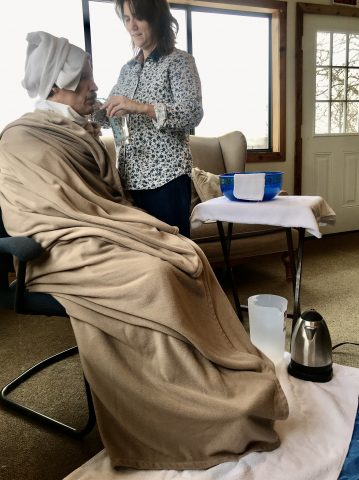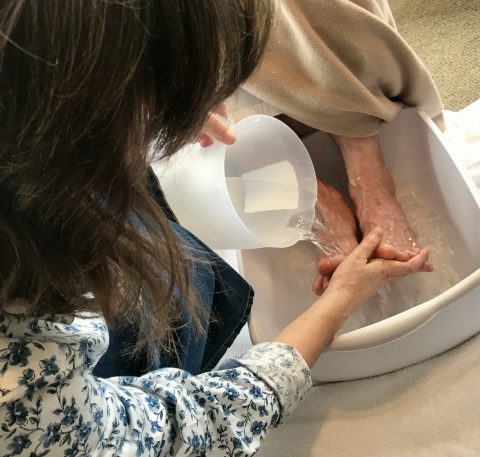
This simple treatment is very helpful to reduce elevated blood pressure, relieve menstrual cramping or headaches, and promote healing of colds and flus. By dilating blood vessels in the feet, blood flow is directed downward, away from the head, lungs, abdominal and pelvic organs. This action relieves congestion in these body parts, and results in the relief and healing.
The feet are immersed in a tub or container deep enough ideally for the water to level to reach 3 to 8 inches above the ankles. Depending on the condition of the patient, a hot foot bath can be done lying down or sitting up.
If doing the treatment because of a flu or cold and/or if sweating will occur, it is best to wear a hospital gown or loose comfortable clothing or pajamas. If being done for another reason besides illness, such as elevated blood pressure, a headache, or menstrual pain, it’s fine to do it normally clothed with the lower legs and feet uncovered.
Before starting, be sure the environment is comfortably warm and free from chilling drafts. The water in the footbath should be maintained as hot as can be comfortably tolerated. However, if the individual has diabetes or neuropathy in the lower extremities, the water should not exceed about 102º F to be safe against potential burning of the skin.
Continue the treatment for about 20 minutes, adding hot water as needed to keep it as hot as the patient can comfortably tolerate. If necessary, remove some of the water with a pitcher to make room for the added hot water.

Conclude the treatment by lifting the feet out of the water and pouring cold water over the feet. This closes the blood vessels down, and, contrary to what you might think, helps to prevent chilling.
After the treatment is finished, it is important, if sick, to rest for a minimum of about 20 minutes in a comfortably warm bed. This allows the immune-enhancing and healing mechanisms stimulated by the treatment to work.
Little children can be conveniently given this treatment sitting by the side of a sink.
Be sure to consult with your medical provider should you have any concerns about the safety of this treatment for your individual case.
Equipment needed:
- Container big and deep enough for feet to be covered with water ideally at least three to eight inches above the ankles
- Teapot or other container with very hot water
- Pitcher for cold water
- Basin with cold water (ice optional) and washcloth
- Towels
- Water for drinking
- Sheet and blanket (depending on condition of patient)
- Plastic sheet (depending on where treatment is done)
Giving a footbath to someone lying down
If done while lying down on a bed or other surface, you may want to drape the area with a piece of plastic, covered by a sheet. This will protect the mattress or surface from water drips and from the patient’s potential sweating. Lay a towel across the foot of the bed and set the foot tub on it. Fill with warm water about half to three quarter full. Have the individual lie down on their back, and with knees bent, rest their feet in the tub. Gently lower the feet in, to test that the water is not too hot. If too warm, add a bit of cool water. If not warm enough, add some hot water.
Cover the individual and the foot tub with a sheet and blanket to prevent chilling, being careful not to let the sheet fall in the water. If the individual begins to feel hot, place a cool washcloth over the forehead to keep the head from overheating. Refresh and replace as often as needed. The individual may also need water to drink, with a straw if easier while lying down, to replace fluid lost during sweating. As mentioned above, once the footbath is finished, lift the feet up out of the water, pour the cold water over them, then dry thoroughly and put warm socks on to prevent chilling.
If the patient is sweaty, uncover and briskly rub the skin of their body one part at time (to prevent chilling) with a cool washcloth. Dry the skin, and have patient put on dry pajamas or gown, and rest for at least 20 minutes in a dry and warm bed. This rest time is critical to allow the body to give the healing mechanisms activated by the treatment to work. To conclude, the patient can take a tepid to moderately warm shower if desired, to rinse off any residual sweat.
How to do footbath sitting
If doing the treatment sitting up, the easiest way, especially if you are giving the treatment to yourself, is sitting by the side of or on the side of the bath tub. Place a tub under the hot water spigot and fill with water as hot as comfortably tolerable. If doing the treatment to fight a cold or flu, it might be most comfortable to wear a hospital gown, pajamas, or other loose comfortable clothing to accommodate sweating. Wrap yourself with a sheet and blanket. Add hot water from the tap as necessary to keep the water hot as comfortably tolerable. Have a container with cold water (with ice cubes if desired) and washcloth within reach. As you begin to feel warm, place the cool washcloth over your forehead to keep your head from overheating. Drink water as needed to replace fluid lost while sweating. After about 20 minutes, lift your feet out of the warm water and run cold water over them. If your entire body is sweaty, just unwrap yourself and take a brief moderately warm to cool shower, then dry yourself well, put on dry pajamas and socks and rest.
If patient is unable to sit by the bathtub, the treatment can be given sitting on a chair. Follow the same basic procedure as described above, but place a piece of plastic if desired and towel on the floor beneath the foot tub to keep the floor dry.
